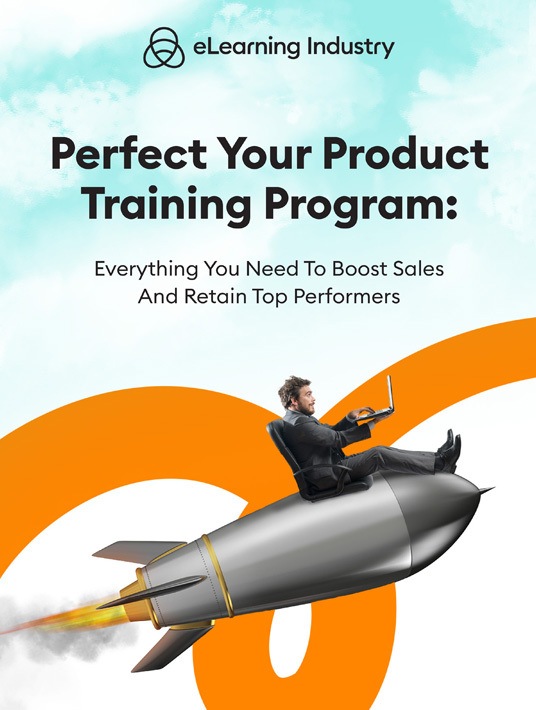How To Take Your Product Training Program To The Next Level
Every organization should consider a product training program for their team, even SMBs with limited budgets and small (but ever-expanding) inventory. But how do you launch new initiatives and identify areas for improvement in your existing sales training strategy? There’s no exact formula to increase your sales stats and improve CX, but there are tried and true methods that can help you achieve success on your own terms. This ultimate guide explores the ins and outs of successful product knowledge programs, from insider outsourcing secrets to inspired training activities for external sales channels. First, let’s review some of the reasons why smaller companies should implement sales enablement and product knowledge support.

What's Inside This Guide...
- Why Is Product Knowledge Training Important For Startups And SMBs?
- Product Training Activities That Are Always Worth The Investment
- Tips To Develop Targeted Product Knowledge L&D Objectives
- Innovative Uses for Product Knowledge Games in Sales Online Training
- Inspired Product Knowledge Training Ideas For External Sales Channels
- Insider Secrets To Choose The Best Product Training Content Provider For Your Budget
1. Why Is Product Knowledge Training Important For Startups And SMBs?
Customers have certain standards, regardless of how many people you employ or which products you provide. A successful sales training strategy can help you expand your base because employees know how to emphasize the key selling points. They also have the opportunity to build skills that tie into sales to ensure an amazing customer experience. Thus, satisfied consumers are more likely to refer people to your brand and increase your annual sales. In addition, you can venture into new markets by establishing a rapport with customers and enhancing your reputation. Paying customers turn into online brand advocates who spread the word about you via social media. Here are a few other reasons to consider product training courses for your SMB or startup:
Avoid Product Returns
Consumers don’t want to go through the hassle of returning products, but sometimes it can’t be avoided, especially if your employees misled them during the sales transaction or exaggerated the benefits. Not only are they disappointed with the item but the service they received. Customers may even feel like they’ve been tricked. A product training program helps reduce return rates because consumers have all the information that they need to make the best buying decision. Decisions that aren’t based on false claims or outdated product info.
Keep Your Top Performers
Many organizations focus on consumer satisfaction because they regard them as their most valuable asset. However, employees also expect the VIP treatment from your organization. They need ongoing support tools, JIT training, and a personalized product training library to fulfill their job roles. Therefore, an effective sales training program can help you retain top talent and boost their workplace performance. This results in lower recruiting, hiring, and onboarding training costs because you don’t have to pay for their replacements.
Impart Essential Service Skills
Product knowledge training is much broader than features and practical uses. It also cultivates essential customer service skills and competencies that surround the sales process, from communication skills to compliance policies, such as safe handling protocols. As a result, employees live up to customer expectations and increase conversions. Ideally, your strategy involves every aspect of consumer engagement, including how to find the right product and follow up after the sale.
Assess Hidden Strengths And Weaknesses
Winning product knowledge training activities disclose personal areas for improvement and individual strengths. Thus, employees are able to fill gaps autonomously and continually develop their talents. This includes performance knowledge assessments that test their mastery and sales performance behaviors. For example, a simulation or scenario helps staffers zero in on negative habits or product benefits they overlooked. It’s all discreet and self-paced so that nobody has to worry about losing face in front of peers or customers.
Prep For Product Launches
Get your team ready for product rollouts long before they hit the shelves. How many times have staffers been caught off guard by a customer who knows more about the upcoming launch? Product knowledge training ensures that your employees are the first to hear about the new product line or services. Tutorials, live events, and demo videos recap the selling points and perks. Another reason to launch a product knowledge training program for SMBs is to interact directly with customers. They can also attend these pre-launch events and Q&As to learn about your new offerings.
2. Product Training Activities That Are Always Worth The Investment
It’s difficult to determine which training resources will pay and which will fall flat. Unless, of course, you have access to an L&D fortune teller who can lend you a unique brand of expertise. Otherwise, you’ll have to rely on tried and tested tools that have worked in the past. But how do you know which materials will outperform the rest if there’s no track history to go by? For example, you’re an SMB who’s switching from ILT to online. Here are 7 product training ideas that organizations turn to time and again to get the best value for money.
Video Demos
Employees need to see how it’s done. I’m not referring to sales tactics or tasks, but how to use the product itself. They can’t pitch it without knowing how it works, right? Develop video demos that show them the ins and outs of setup, customization, and basic troubleshooting. For example, how do customers charge the device? What should they do if they need to restore the factory defaults? These demos allow employees to showcase your products in the most favorable light and highlight the key selling points, not to mention, avoid the most common mistakes that might cost them the sale.
Selling Point Infographics
Another great way to emphasize the USPs is to create memory refresher infographics. These point out the top 5 or 6 benefits the product brings to consumers, as well as some standout features that may win them over. Include relevant images or charts to provide a visual example. For instance, they can show consumers how easy it is to personalize the home screen or install the software on their laptops. Make infographics mobile-friendly so employees can view them on the go and reinforce their product training know-how.
Sales Simulations
Knowing all the product specs is one thing, but employees must be able to touch on all the key points during the transaction. Sales simulations give them the opportunity to interact with virtual customers and identify product knowledge training gaps, as well as performance behaviors that are holding them back. For example, they need to find the perfect product for the customer based on their budget and primary concerns. This requires a broad skillset, from active listening to problem-solving. But, they also have to know the features, specs, and benefits of your entire product line.
Pain Point Checklists
Customers are in the market for new products and services because there’s a void. Maybe they need a device to improve fitness or retain their mental sanity. Whatever the case, a qualified lead has obstacles to overcome, even "frivolous" purchases serve a purpose in their lives (i.e., retail therapy or gift-giving), otherwise, they wouldn’t devote the time, money, or energy to researching your brand or visiting your establishment. Compile a checklist of the top pain points for each target demographic. What are they looking for in a productivity app? Which issues can your software help them address? Highlight the main sticking points your products will help them resolve so that employees can personalize the pitch.
Live Event Launches
Not all successful product training program ideas are structured or autonomous. Host a live event launch for every new product before it hits the (virtual) store shelves. This gives your staffers the chance to learn all about the creative uses, real-world benefits, and usage instructions. You can also address any questions they have about the product, its unique selling points, and popular myths. It even clears up any confusion regarding the specifications, upkeep, and add-ons. Now’s the time to ensure that their product know-how is based on fact so that they don’t pass on inaccurate info.
Social Media Pointer Groups
Launch social media support groups that feature a new tip every day. You can either post them yourself or encourage top performers to share their expertise with co-workers. Just make sure the group doesn’t turn into a ranting forum, complete with customer horror stories. It’s perfectly fine to commiserate with peers, especially if the story helps someone overcome similar challenges; for example, dealing with difficult customers or showcasing products that are more involved. Set some guidelines so that everyone knows how to participate without creating conflict. There should also be a moderator to keep comments in check and keep the conversation going.
Customer Profile Serious Games
Another way to incorporate more interactivity and real-world application into your product sales training program is serious games. In this case, gaming experiences that feature customer profiles and product matching. Trainees must peruse the entire catalog to find the best goods/services for the consumer based on their needs and expectations. You should also include buying behaviors, past purchases, and basic demographics. Employees need the complete picture to select products that resonate with them and their everyday challenges. Provide immediate feedback to identify hidden areas for improvement and follow-up resources to expand their product knowledge.
3. Tips To Develop Targeted Product Knowledge L&D Objectives
Vague objective statements are the downfall of many L&D initiatives, regardless of business size or available resources. Employees are unable to monitor personal progress and admins can’t identify hidden areas for improvement because there are simply no benchmarks to go by. Your organization needs to define its parameters for success and how you’ll gauge everything, from employee proficiency to activity efficacy. Thus, clear and concise product knowledge training objectives must serve as the foundation for strategy. Follow these 8 tips and tricks to develop targeted statements for your sales online training program.
Set Measurable Outcomes
There must be a way to monitor effectiveness and employee progress. This is where measurable outcomes enter the picture. Determine what you need to achieve to warrant the investment, as well as which performance behaviors you’ll focus on. Be specific regarding KPIs, product sales stats, etc. For example, employees must increase their customer service stats by X percent by the end of the quarter. These measurable outcomes should not involve assessment scores alone but real-world application and business goals.
Assess Employee Knowledge Gaps
Now that you know what employees must accomplish, you need to disclose their current areas for improvement. What do they know about the products and services? Which skills do they possess? Which talents or product info do they lack? Conduct assessments, surveys, and job evaluations to identify their professional pain points. Then use the data to customize your product training objectives. It’s also best to include diverse assessment types to cater to different preferences and styles.
Identify Key Product Sales Tasks
It’s not just how much they know about the product, but if they can pitch it to customers without exaggerating claims, or ring up purchases and deal with common obstacles. For instance, are they able to operate the POS software? Can they quickly identify customers’ needs and seal the deal before the next person in line walks away empty-handed out of frustration? The essential sales tasks also factor into your product training objectives and outcomes.
Clarify Expectations And Assessment Methods
What methods will you use to evaluate employee proficiency and product mastery? Clarify your expectations, assessment types, and criteria so that employees know what’s in store. This also helps them focus on behaviors, skills, and product info that’s relevant to your organization, instead of stressing about training topics that are irrelevant to their job titles or support outdated organizational objectives.
Get Employees Involved
Your L&D team is typically responsible for objectives, but trainees are the ones who have to build on their existing knowledge to achieve the outcomes. As such, they should play an active role in developing your project knowledge training objectives for your organization. Get their input regarding gaps in your current strategy and identify areas for improvement. For instance, a majority of your staffers believe that the sales targets are unreasonable, especially given the short time frame and steep industry competition. Thus, you may have to adjust your statements accordingly based on their insightful (and realistic) feedback.
Reevaluate Objectives To Support Current Outcomes
Though employee input may be a catalyst for change, you must also reevaluate objectives periodically to verify relevancy. Do you still have the same sales challenges? Is there a better way to evaluate employee performance? Every objective you implement should align with current outcomes and employee expectations, needs, and experience levels. Since you’re already taking a deep dive into objective statements, you might consider a budget review just to make certain that all your expenditures are accounted for and you’re properly allocating resources to achieve those desired outcomes.
Keep It Simple And Short Term
The secret to successful product knowledge objectives is simplicity. Don’t try to cast the net too wide and create paragraph-long statements that sum up the entire sales training program. Develop concise objectives that target specific product niches and sales goals. Break more complex outcomes into separate objectives so that they’re more manageable and easier to track. Keep in mind that humans like instant gratification. Thus, short-term aims will boost employee motivation and active participation. They can monitor their progress and check secondary goals off their list as they bridge knowledge gaps.
Hire An Outsourcing Partner
Many organizations bring in third-party providers after they’ve conducted a TNA and developed targeted goals. But, they can also lend their expertise during this crucial phase of the project. An outsourcing partner knows what it takes to achieve the outcomes within budget and expedite the implementation timeline, as well as the best delivery methods to improve knowledge retention and recall. They’re also aware of how to accurately measure trainee proficiency and identify hidden gaps to cultivate in-house talent. So, consider hiring an eLearning content provider from day one to analyze your current strategy and develop actionable objectives. This even puts them in a better position to create content because they were part of the goal-setting phase. They’re aware of your unique requirements, budget limitations, and employees’ pre-existing knowledge.
4. Innovative Uses for Product Knowledge Games in Sales Online Training
Sales is already a game of sorts. Employees need to identify customer needs, match them with the right product, and overcome all the obstacles in between. Sure, you’re missing the final boss battle, but a stubborn customer who wants to haggle for a lower price might fill that role. As such, product training program games are the perfect addition to your strategy, especially if you get creative and use them to bolster skills, real-world experience, and identify hidden gaps. Here are 8 innovative ways to incorporate games into your existing training plan.
Test Customer Service Competencies
Employees may know their way around the product inventory, but can they persuade customers to purchase or find the ideal item for new clients based on buying behaviors and expectations? Use product knowledge games to test their skills application in real-world settings. For example, they must use active listening and problem-solving skills to identify the customer's needs, then let their product know-how take over. These games highlight areas for improvement discreetly so that employees can work on their interpersonal abilities.
Gauge Their Level Of Product USP Mastery
How well do employees know the features and functions? Looking up the unique selling points in the middle of a sales pitch is usually frowned on. Customers perceive it as a lack of experience and professionalism. Your sales and customer service team are supposed to be brand advocates. Thus, they must possess a high level of USP mastery. Develop product knowledge serious games that assess their proficiency and disclose hidden gaps. It might involve a drag-and-drop activity where they choose from a list of selling points, then match it with the corresponding item, or even a simulation that features customer personas with targeted pain points and they must pick the perfect product.
Expose Them To Challenging Sales Scenarios
Not every pitch goes off without a hitch. Rhymes aside, overcoming challenges is serious business, especially if employees are already stressed to begin with. One of the most inspired product training ideas is to expose them to workplace obstacles that build real-world experience. For example, there’s an angry customer who is dissatisfied with their recent purchase. How can they appease them with a replacement product or add-on? Which other products will address pain points that the previous item overlooked?
Survey Employees’ Showcase Skills
Sales employees need to show off the product’s standout features without seeming too gimmicky. You don’t want customers thinking they’re on a game show and you're revealing the grand prize. Then again, fumbling around with the product is also cause for concern. Incorporate product knowledge games to assess your employees’ showcasing skills on the job. Do they point out all the practical uses? Are they able to demonstrate how the product works and basic maintenance instructions?
Product Benefit Recaps
The fine art of persuasion is all about turning selling points into practical perks. Can your employees convey the real-world benefits of ownership? Recap the most notable reasons to purchase the product in your next sales training serious game. You can even take the retro game show approach to convert those boring pop quizzes into engaging assessments, complete with points and virtual contestants to boost competition.
Match Customer Buying Behaviors With Product Perks
Include customer personas that cover everything from demographics to past purchases. Then, encourage employees to choose products based on their buying behaviors. For example, maybe the customer needs the newest (upgraded) item in the same product line to stay on top of trends. This also allows them to see the connection between historic buying patterns and how those purchases influence consumer choices today.
Proper Handling Protocols
Some products require special handling instructions to avoid injury. Or, maybe the product itself features moving parts that are easily damaged. Create sales online training serious games that reinforce proper handling protocols and compliance issues. For instance, leaving the product on the self may void the insurance policy in the event of theft. So, employees need to lock it up before they help the next customer in the game.
Sales Mishaps
The beauty of a successful online product training program is that employees get to learn from their mistakes. But, it doesn’t necessarily have to be their mistakes. Develop serious games that involve the most common on-the-job errors, then invite trainees to explain why the character’s performance was flawed and how they can remedy the situation. This also prompts employees to reflect on their own habits and work practices.
Bonus Tip: Spark Friendly Competition With Product Knowledge Leaderboards
Product knowledge games are just one part of the plan. You can also incorporate leaderboards to enhance motivation and spark friendly competition among co-workers. For example, they earn points every time they successfully complete the game and earn a high score. This moves them one spot up the leaderboard and provides immediate feedback. They know they’re on the right track. More importantly, peers can mimic performance behaviors and bridge knowledge gaps because the top performer sets the example.
5. Inspired Product Knowledge Training Ideas For External Sales Channels
Not every member of your staff has the luxury of asking managers for advice or following their co-worker’s example. External sales teams usually fly solo and are geographically dispersed. They must be able to access relevant resources on the go to catch up on product launches and refresh their memory. They also need to utilize peer-based support tools to collect feedback and learn from one another's experiences. This means you may have to get creative when developing your external partner product training to stay within budget and achieve desired outcomes. These inspired product training ideas for external sales channels can help your team perfect their pitch and hone their talents from afar.
Product Personal Anecdotes
External sales channels need to know that they’re not alone regarding customer challenges and sales obstacles. Personal anecdotes help them emotionally connect and put the information into context. For instance, the narrator talks about how they showcased the new product line to an indecisive customer and won them over. You can also feature stories that highlight the product benefits in the real world. Satisfied customers are usually happy to share their success stories, which you can pass on to trainees.
Social Media Support Groups
Launch social media groups for sales channels that need more personalized, JIT support. This group is reserved for external partners with similar challenges and training requirements because they work remotely. Feature daily tips or conversation starters to boost online collaboration and peer-based feedback. Or host live Q&As to give everyone the opportunity to clear up confusion about the upcoming product launch. Don’t forget to pin the overall objectives and guidelines to the top so that everyone knows how to participate in the discussion.
Live Event Product Recaps
One of the most interactive and engaging types of product training is live events. Top performers, vendors, and managers can serve as guest hosts. Or you can invite a well-known industry expert to share their insights with the group. The purpose is to recap a different product or line for each event so that you cover all the essentials. Sales channels can prepare their list of questions and concerns to perfect their pitch. For example, they’re still unsure how to set up the new device or how to properly maintain the new product.
Sales Gamification Boards
Successful product knowledge ideas encourage sales channels to share their knowledge while still retaining their independence. Sometimes the best way to facilitate peer-to-peer interactions is through friendly competition. So, launch sales gamification boards to motivate your external partners and identify hidden areas for improvement. Why are they slipping in the ranks while another member of the team is skyrocketing to the top? Can they learn something from this colleague to boost their own sales stats? Create separate leaderboards for every phase of the employment cycle to keep them engaged. For instance, new hires shouldn’t have to compare their performance to a partner who has been in the business for years. They’re at different phases of their career and have different success criteria.
USP Refresher Games
Why is product knowledge important to external sales teams? One of the most notable benefits is refreshing and reinforcing product info, from how the item functions to upkeep instructions. But sales channels must also understand the unique perks it brings to consumers. Develop USP serious games to remind them of the key features they should emphasize during the pitch. For example, they need to find the best product based on the consumer’s buying habits. Employees must master the entire product catalog and the primary selling points to mention for each customer group.
Innovative Use Video Demos
Products are usually intended for a specific purpose or pain point. They’re designed with targeted outcomes and customer needs in mind. However, your team may uncover new and creative ways to use the product to broaden their marketing scope. Develop innovative use video demos that show them all the lateral-thinking applications for the product. Of course, the video should also address improper uses to cover all your bases or exaggerated claims that sales channels should avoid. For instance, they probably shouldn’t mention that your time management app is guaranteed to help the customer shed unwanted pounds. The key is getting creative…not farfetched.
User-Generated Sales Presentations
Invite your top sales channel partners to develop presentations for the product training program library. They must sum up the essential product info then put it into their own words, as well as compile all the crucial sales data. Peers can access the presentation online to benefit from insider expertise. While your organization reduces its training expenses because you don’t have to create as much L&D content, assign a different product to every team member to avoid redundancies. You should also require admin approval before they upload resources to ensure product accuracy. You don’t want sales teams passing on falsehoods to consumers simply because the original content creator misunderstood the USPs.
6. Insider Secrets To Choose The Best Product Training Content Provider For Your Budget
You’ve made a successful business case and have finally decided to outsource certain aspects of your product training program. Now comes the fun part. You must endure the stressful, resource-draining, and somewhat agonizing process of choosing the right eLearning solutions vendor. The mere thought of scouring the web for suitable candidates and evaluating countless portfolios is enough to make you queasy. But hiring the ideal eLearning content provider for your project doesn’t have to be a headache. Just follow these 8 insider secrets to compile a shortlist quickly and select product training solutions that don’t push you out of your fiscal comfort zone.
Clarify Your Price Point And Development Time Frame
Before you can get down to outsourcing, you need to know your price range. How much can you realistically spend on an eLearning content provider? How quickly do you need to deploy your product training program? What have you already allocated to in-house development? These questions can help you determine your ideal price point for your outsourcing budget.
Save Time With An Online Directory
An online eLearning content provider directory features all the top vendors in one centralized location, which speeds up the process and helps you evaluate your top choices side by side. Another perk of using a reliable directory is unbiased overviews. You can accurately gauge their areas for specializations, niches, and backgrounds to choose the best outsourcing partner for your budget.
Evaluate Vendor Specializations
Every eLearning content provider has areas where they excel. It’s essential to find a vendor who knows your niche inside out and its unique training obstacles. This is particularly important for product knowledge training since they must create content that covers everything from selling points to real-world benefits. This requires detailed knowledge of the product line, consumer pain points, and sales techniques. Of course, they may still need time to bring their team up to speed and master product features and functions. However, industry experience gives them a notable head start.
Request A Quote
Ask the vendor for a free quote to get a general idea of how much they charge and what’s included in the price. eLearning content providers usually have a list of questions to help them customize estimates. For instance, the size of your project, which solutions you require, and how many employees you have on the payroll. You can always follow up to get a more detailed expense sheet later on.
Read User Reviews To Get The Best Value For Money
You can learn a lot from companies who’ve come before, namely organizations that have already hired the eLearning content provider and can shed light on customer service, communication, and so on. Read user reviews to gauge their experience and get the best value for money. Of course, there’s no guarantee that the content provider will deliver the same level of support for your company. But, a solid track record is usually a good indication of professionalism and commitment to quality.
Go Over The Fine Print
Ask to see a copy of their contract to evaluate the fine print. Another great way to delve into the details (because that’s where the devil is usually lurking) is to analyze their website. How is the overall style and aesthetic? Do they have a sample of their work? Are there terms and conditions you can read beforehand? Get a feel for their expertise and design skills. Lastly, ask for referrals and reach out to clients who can highlight the vendor’s core strengths. Did they have any issues with the contract? Did the content provider deliver on schedule? Were they able to achieve their objectives without going over their product training program budget?
Consider Their Complete List Of Solutions
Review the product knowledge outsourcing solutions they provide and compare them to your shopping list. For example, you don’t just need a partner for sales enablement and product training, but microlearning and TNA. Do they deliver the complete package or will you have to hire multiple vendors for the project? Another thing to consider is solution diversity. Do they stretch themselves thin by offering too many types of product training? Or do they dedicate their time, energy, and talents to perfecting training resources in limited categories? For example, they may not tackle VR but their simulations and scenarios are top-notch.
Discuss Project Scope
Contact the vendor to clarify the scope of your project and possibly even set up a meeting to discuss the budget and training requirements. Their free quotes are somewhat limited because they are unaware of your expectations, existing resources, and objectives. So, outline your entire training plan to give them a better sense of your product knowledge must-haves. Finally, share your future projects to plan ahead and determine if they’re long-term patterns. It’s perfectly alright to hire an outsourcing partner for a one-off project. Just bear in mind that you’ll have to go through the selection process all over again when it’s time to implement new solutions.
Conclusion
A product training program benefits your entire workforce and even external partners who advocate your brand on a global scale. But you need all the crucial components to keep them fully engaged and make it personal. You can also use our online directory to choose the best outsourcing partner for your product training program. It features ratings, reviews, and complete solutions lists to help you find the right content provider in your price range.
Before you launch your new strategy, read our exclusive guide to identify sticking points and discover innovative product training tools. Get your copy of Perfect Your Product Training: Everything You Need To Boost Sales And Retain Top Performers today to hit those targets and expand your market reach.









